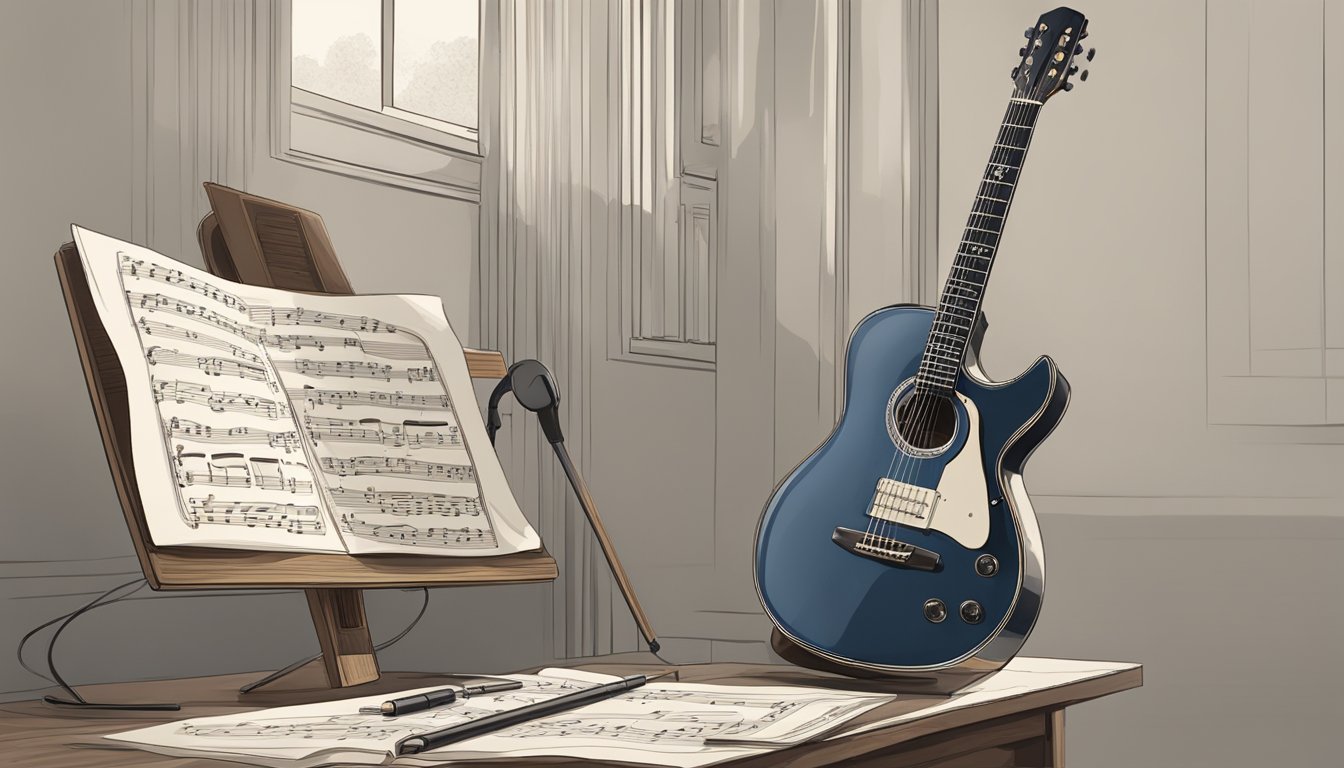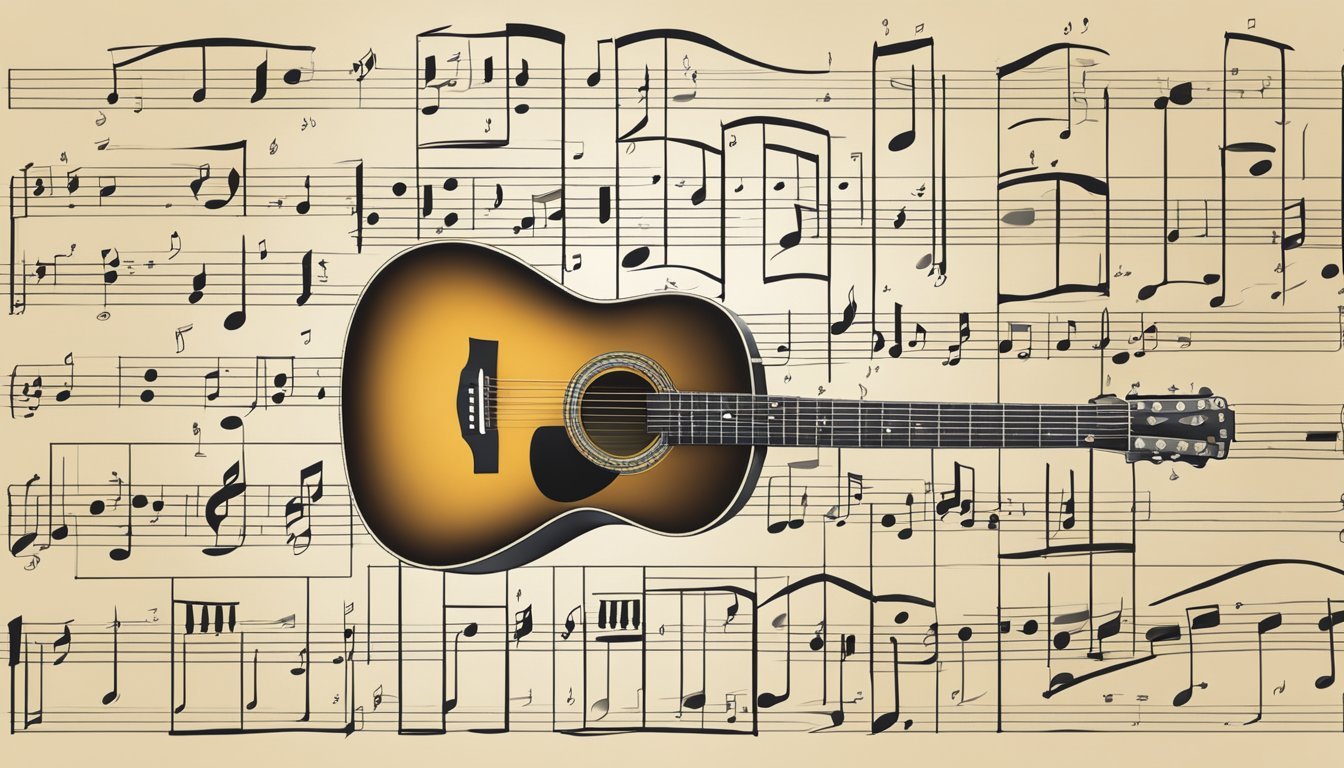Learning how to read sheet music for guitar can feel overwhelming at first.
However, you’ll find that reading music opens up a whole new world for guitarists.
Once you grasp the basics of music notation, it becomes much easier to play your favorite songs and improve your skills.
From understanding notes on a staff to recognizing different rhythms, you’ll find that reading music opens up a whole new world for guitarists.

You’ll often encounter standard notation and tablature, which each offer unique insights into how to play.
Mastering these elements helps you to not only follow along but also to express yourself more freely as a musician.
Whether you’re just starting or looking to sharpen your skills, understanding sheet music will take your guitar playing to the next level.
Key Takeaways
- Learn the basics of music notation for effective reading.
- Understand rhythms and how they impact your playing.
- Use practical tips to enhance your sheet music reading skills.
Fundamentals of Music Notation
To read guitar sheet music effectively, you need to grasp some basic concepts of music notation.
This includes understanding the staff, how notes and clefs work, and what key signatures mean.
Let’s break each of these down.
Understanding the Staff
The staff is made up of five lines and four spaces where notes are placed.
Each line and space represents a specific pitch.
For the guitar, you’ll mainly use the treble clef.
The notes on the lines, from bottom to top, are E, G, B, D, and F. You can remember this phrase: “Every Good Boy Deserves Food.”
The spaces spell out the word FACE.
This layout helps you identify notes quickly.
Sometimes, you may encounter ledger lines, which are additional lines for notes that go above or below the staff.
Recognizing Notes and Clefs
Notes are the symbols that tell you which sound to play.
A full black dot with a straight stem represents a quarter note, while a note with a flag shows it’s shorter.
For guitar, the treble clef is used most.
The treble clef looks like an ornate “G,” showing you where the G note is on the staff.
If you see a bass clef, which looks like a fancy “F,” it’s used for lower notes.
Knowing these clefs is crucial for interpreting music accurately.
Deciphering Key Signatures
Key signatures appear at the beginning of a staff and tell you which notes are sharp or flat throughout the piece.
This helps you understand the mood of the music.
For instance, a key signature with one sharp means you’re in the key of G major.
Each additional sharp or flat changes the key, so pay attention!
Key signatures simplify your playing because they save you from constantly writing sharps or flats next to every note.
Understanding this concept will make your practice easier and help you enjoy playing more.
Rhythms and Beats in Guitar Music
Understanding rhythms and beats is key to playing guitar well.
This section covers how to count time signatures, recognize note values, and incorporate rests in your music.
Counting Time Signatures
Time signatures tell you how many beats are in each measure and what note gets the beat.
The most common time signature is 4/4.
This means there are four beats in a measure, and a quarter note gets one beat.
Other common time signatures include 3/4 (three beats per measure) and 6/8 (six beats per measure).
When you see a time signature, remember to count the beats in each measure.
This helps you feel the rhythm while playing.
Note Values and Durations
Note values show how long to hold each note.
Here are the basics:
- Whole Note: 4 beats
- Half Note: 2 beats
- Quarter Note: 1 beat
- Eighth Note: 0.5 beats
- Sixteenth Note: 0.25 beats
You can also extend note durations with dots.
A dot adds half the value of the note.
For example, a dotted half note equals 3 beats (2 + 1).
Ties can join two notes of the same pitch, allowing you to hold one note longer.
Incorporating Rests and Beats
Rests are just as important as notes because they create space in music.
Here are some common rests:
- Whole Rest: 4 beats of silence
- Half Rest: 2 beats of silence
- Quarter Rest: 1 beat of silence
- Eighth Rest: 0.5 beats of silence
Using rests helps you create rhythm and flow in your playing.
Count your beats and include rests where needed to keep your timing steady.
This makes your music feel complete and engaging!
Playing Techniques Notation for Guitar

When you read sheet music for guitar, you’ll encounter various symbols and techniques that guide your playing style.
Understanding how to interpret these notations is key to improving your skills.
Understanding Tablature and Standard Notation
Guitar tablature, or tabs, is a popular way to read music for guitar.
It uses numbers on lines to represent the strings and frets.
Each line stands for a string, with the bottom line being the low E string.
For example, a “3” on the second line means to press down the 3rd fret of the A string.
Standard notation, on the other hand, uses musical symbols on a staff.
This includes notes, rests, and other markings.
You might see a dotted note, which extends the note’s duration.
Using both tablature and standard notation can help you play accurately and expressively.
Articulations and Ornaments
Articulations and ornaments add character to your playing.
Key techniques include hammer-ons and pull-offs.
A hammer-on involves playing a note and then using a finger to press another note on the same string without picking.
This creates a smooth transition between notes.
Pull-offs work in the opposite way.
You play a note and then pull your finger off to let a lower note ring out.
Both techniques offer a fluid sound and can make your playing more dynamic.
Music symbols like curved lines help indicate these techniques, so keep an eye out for them in your tabs or sheet music.
Chords and Strumming Patterns
Chords are essential in guitar playing, represented through chord diagrams.
These diagrams show the finger positions for different guitar chords.
For example, a common chord, C major, indicates where to place your fingers on the fretboard.
Strumming patterns add rhythm to your playing.
They can vary from simple downstrokes to more complex patterns.
In sheet music, you’ll often see symbols indicating how to strum.
Keeping consistent with these patterns helps maintain the song’s flow.
Whether using a pick or your fingers, mastering these patterns is crucial for your overall guitar skill.
Practical Tips for Reading Guitar Sheet Music
Getting the hang of guitar sheet music can be a game-changer in your playing.
Focus on tools like metronomes and tuners, and dive into practicing different scales to sharpen your skills.
Using Metronomes and Tuners
Using a metronome can help you keep a steady tempo while you practice.
Start slow, especially with new pieces.
As you get more comfortable, gradually increase the speed.
This is crucial when you see repeat signs; you’ll want to nail those sections at the right speed.
A tuner is equally important.
Make sure your guitar is in standard tuning before you start reading sheet music.
This ensures that the notes you play match what’s written on the staff.
You don’t want to practice wrong notes! Simply tune each string for clarity and accuracy.
Practicing with Different Scales
Understanding scales can really enhance your guitar playing.
Start with the C Major scale; it’s a foundational scale that helps you read notes and get comfy with the fretboard.
Try playing the A Major scale next, which adds sharps and gives you a different flavor.
Practice playing these scales in time with your metronome.
This will help you connect music theory to practical playing.
You’ll discover how notes on the staff translate to actual guitar notes.
Each time you practice, pay attention to the notation and familiarize yourself with how different scales are written.
Frequently Asked Questions
Learning to read guitar sheet music can feel tricky at first, but it gets easier with practice.
Here are some common questions that can help you on your journey.
As you familiarize yourself with the notes and symbols, you’ll begin to recognize patterns that make deciphering the music more intuitive.
Many online resources and apps offer tutorials and exercises specifically designed to help you learn how to read sheet music effectively.
The key is to be patient and consistent; over time, you’ll notice significant improvements in your ability to interpret musical scores.
What’s the easiest way to start reading guitar sheet music?
The best way to start is by familiarizing yourself with the basics of the treble clef.
Learn the note names on the lines and spaces.
You can use simple memory aids, like “Every Good Boy Deserves Food” for the lines.
What are the differences between guitar tabs and sheet music?
Guitar tabs show you where to place your fingers on the fretboard, making them straightforward for beginners.
Sheet music uses notes to represent pitch and rhythm, which gives you a more complete understanding of music.
How can beginners learn to read guitar notes from sheet music?
Start with simple songs that you enjoy.
Use flashcards to memorize notes and practice reading them regularly.
Slowly increase the complexity as you become more comfortable.
What’s a good way to learn reading guitar chords from sheet music?
Focus on common chord shapes and their corresponding notes.
Practice playing the chords while reading them in sheet music.
This will help connect the dots between what you see and what you play.
Are there free online resources to help learn to read music for guitar?
Yes, many websites offer free lessons, practice exercises, and videos.
Look for platforms like YouTube, music theory websites, and guitar learning sites like National Guitar Academy to find helpful resources.
Does understanding sheet music make playing guitar easier or harder?
Understanding sheet music can make playing guitar easier in the long run.
It helps you read and play music more accurately.
Plus, it opens up a wider variety of songs and styles you can learn.

